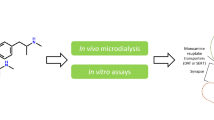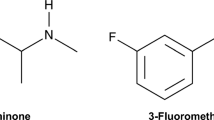Abstract
Rationale
The neurochemical effects produced by acute administration of 3,4-methylenedioxymethamphetamine (MDMA) on the monoaminergic systems in the brain are well documented; however, there has been little consideration of the potential effects of MDMA on other neurotransmitter systems.
Objective
The present study was designed to investigate the acute effect of MDMA on cholinergic neurons by measuring acetylcholine (ACh) release in the medial prefrontal cortex (PFC) and dorsal hippocampus, terminal regions of cholinergic projection neurons originating in the basal forebrain.
Methods
In vivo microdialysis and high-performance liquid chromatography with electrochemical detection (HPLC-ED) were used to assess the effects of MDMA on the extracellular concentration of ACh in the PFC and dorsal hippocampus of the rat.
Results
The systemic administration of MDMA (3–20 mg/kg, i.p.) resulted in an increased extracellular concentration of ACh in the PFC and dorsal hippocampus. Reverse dialysis of MDMA (100 μM) into the PFC and hippocampus also increased ACh release in these brain regions. Treatment with parachlorophenylalanine and α-methyl-para-tyrosine, inhibitors of serotonin (5-HT) and dopamine (DA) synthesis, respectively, significantly attenuated the release of ACh stimulated by MDMA in the PFC, but not in the dorsal hippocampus.
Conclusions
MDMA exerts a stimulatory effect on the release of ACh in the PFC and dorsal hippocampus in vivo, possibly by mechanisms localized within these brain regions. In addition, these results suggest that the MDMA-induced release of ACh in the PFC involves both serotonergic and dopaminergic mechanisms.






Similar content being viewed by others
References
Acquas E, Fibiger HC (1996) Chronic lithium attenuates dopamine D1-receptor mediated increases in acetylcholine release in rat frontal cortex. Psychopharmacology (Berl) 125(2):162–167
Acquas E, Marrocu P, Pisanu A, Cadoni C, Zernig G, Saria A, DiChiara G (2001) Intravenous administration of ecstasy (3,4-methylenedioxymethamphetamine) enhances cortical and striatal acetylcholine release in vivo. Eur J Pharmacol 418(3):207–211
Arnold HM, Fadel J, Sarter M, Bruno JP (2001) Amphetamine-stimulated cortical acetylcholine release: role of the basal forebrain. Brain Res 894(1):74–87
Arnold HM, Nelson CL, Sarter M, Bruno JP (2003) Sensitization of cortical acetylcholine release by repeated administration of nicotine in rats. Psychopharmacology (Berl) 165(4):346–358
Barnes NM, Sharp T (1999) A review of central 5-HT receptors and their function. Neuropharmacology 38:1083–1152
Beani L, Bianchi C, Giacomelli A, Tamberi F (1978) Noradrenaline inhibition of acetylcholine release from guinea-pig brain. Eur J Pharmacol 48(2):179–193
Bianchi C, Spidalieri G, Guandalini P, Tanganelli S, Beani L (1979) Inhibition of acetylcholine outflow from guinea-pig cerebral cortex following locus coeruleus stimulation. Neurosci Lett 14(1):97–100
Brodkin J, Malyala A, Nash JF (1993) Effect of acute monoamine depletion on 3,4-methylenedioxymethamphetamine-induced neurotoxicity. Pharmacol Biochem Behav 45(3):647–653
Consolo S, Bertorelli R, Russi G, Zambelli M, Ladinsky H (1994) Serotonergic facilitation of acetylcholine release in vivo from rat dorsal hippocampus via serotonin 5-HT3 receptors. J Neurochem 62(6):2254–2261
Consolo S, Arnabaldi S, Ramponi S, Nannini L, Ladinsky H, Baldi G (1996) Endogenous 5-HT facilitates in vivo acetylcholine release in rat frontal cortex through 5-HT1B receptors. J Pharmacol Exp Ther 277(2):823–830
Darvesh AS, Shankaran M, Gudelsky GA (2002) 3,4-Methylenedioxymethamphetamine produces glycogenolysis and increases the extracellular concentration of glucose in the rat brain. J Pharmacol Exp Ther 301(1):138–144
Day J, Fibiger HC (1992) Dopaminergic regulation of cortical acetylcholine release. Synapse 12(4):281–286
Day JC, Fibiger HC (1994) Dopaminergic regulation of septohippocampal cholinergic neurons. J Neurochem 63(6):2086–2092
Day JC, Tham CS, Fibiger HC (1994) Dopamine depletion attenuates amphetamine-induced increases of cortical acetylcholine release. Eur J Pharmacol 263(3):285–292
Day JC, Piazza PV, Le Moal M, Maccari S (1997) Cocaine-induced increase in cortical acetylcholine release: interaction with the hypothalamo–pituitary–adrenal axis. Eur J Neurosci 9(6):1130–1136
Fischer HS, Zernig G, Schatz DS, Humpel C, Saria A (2000) MDMA (ecstasy) enhances basal acetylcholine release in brain slices of the rat striatum. Eur J Neurosci 12(4):1385–1390
Giovannini MG, Ceccarelli I, Molinari B, Cecchi M, Goldfarb J, Blandina P (1998) Serotonergic modulation of acetylcholine release from cortex of freely moving rats. J Pharmacol Exp Ther 285(3):1219–1225
Gough B, Ali SF, Slikker W Jr, Holson RR (1991) Acute effects of 3,4-methylenedioxymethamphetamine (MDMA) on monoamines in the rat caudate. Pharmacol Biochem Behav 39:619–623
Green AR, O’Shea E, Colado MI (2004) A review of the mechanisms involved in the acute MDMA (ecstasy)-induced hyperthermic response. Eur J Pharmacol 500(1–3):3–13
Gudelsky GA, Nash JF (1996) Carrier-mediated release of serotonin by 3,4-methylenedioxymethamphetamine: implications for serotonin–dopamine interactions. J Neurochem 66(1):243–249
Gudelsky GA, Yamamoto BK, Nash JF (1994) Potentiation of 3,4-methylenedioxymethamphetamine-induced dopamine release and serotonin neurotoxicity by 5-HT2 receptor agonists. Eur J Pharmacol 264(3):325–330
Hersi AI, Richard JW, Gaudreau P, Quirion R (1995) Local modulation of hippocampal acetylcholine release by dopamine D1 receptors: a combined receptor autoradiography and in vivo dialysis study. J Neurosci 15(11):7150–7157
Hirano H, Day J, Fibiger HC (1995) Serotonergic regulation of acetylcholine release in rat frontal cortex. J Neurochem 65(3):1139–1145
Imperato A, Obinu MC, Gessa GL (1993) Effects of cocaine and amphetamine on acetylcholine release in the hippocampus and caudate nucleus. Eur J Pharmacol 238(2–3):377–381
Johnson MP, Hoffman AJ, Nichols DE (1986) Effects of the enantiomers of MDA, MDMA and related analogues on [3H]serotonin and [3H]dopamine release from superfused rat brain slices. Eur J Pharmacol 132(2–3):269–276
Jones BE, Cuello AC (1989) Afferents to the basal forebrain cholinergic cell area from the pontomesencephalic catecholamine, serotonin and acetylcholine neurons. Neuroscience 31(1):37–61
Koyama T, Nakajima Y, Fujii T, Kawashima K (1999) Enhancement of cortical and hippocampal cholinergic neurotransmission through 5-HT1A receptor-mediated pathways by BAYx3702 in freely moving rats. Neurosci Lett 265(1):33–36
Lebsanft HB, Mayerhofer A, Kovar KA, Schmidt WJ (2003) Is the ecstasy-induced ipsilateral rotation in 6-hydroxydopamine unilaterally lesioned rats dopamine independent? J Neural Transm 110(7):707–718
Lehmann J, Nagy JI, Atmadia S, Fibiger HC (1980) The nucleus basalis magnocellularis: the origin of a cholinergic projection to the neocortex of the rat. Neuroscience 5(7):1161–1174
Marshall DL, Redfern PH, Wonnacott S (1997) Presynaptic nicotinic modulation of dopamine release in the three ascending pathways studied by in vivo microdialysis: comparison on naïve and chronic nicotine-treated rats. J Neurochem 68(4):1511–1519
Nair SG, Gudelsky GA (2004a) Activation of 5-HT2 receptors enhances the release of acetylcholine in the prefrontal cortex and hippocampus of the rat. Synapse 53(4):202–207
Nair SG, Gudelsky GA (2004b) Protein kinase C inhibition differentially affects 3,4-methylenedioxymethamphetamine-induced dopamine release in the striatum and prefrontal cortex of the rat. Brain Res 1013(2):168–173
Nash JF (1990) Ketanserin pretreatment attenuates MDMA-induced dopamine release in the striatum as measured by in vivo microdialysis. Life Sci 47:2401–2408
Nash JF, Brodkin J (1991) Microdialysis studies on 3,4-methylenedioxymethamphetamine-induced dopamine release: effect of dopamine uptake inhibitors. J Pharmacol Exp Ther 259(2):820–825
Nash JF Jr, Meltzer HY, Gudelsky GA (1988) Elevation of serum prolactin and corticosterone concentrations in the rat after the administration of 3,4-methylenedioxymethamphetamine. J Pharmacol Exp Ther 245(3):873–879
Nelson CL, Burk JA, Bruno JP, Sarter M (2002) Effects of acute and repeated systemic administration of ketamine on prefrontal acetylcholine release and sustained attention performance in rats. Psychopharmacology (Berl) 161(2):168–179
Nelson CL, Sarter M, Bruno JP (2003) Repeated pretreatment with amphetamine sensitizes increases in cortical acetylcholine release. Psychopharmacology (Berl) 151(4):406–415
Nichols DE, Lloyd DH, Hoffman AJ, Nichols MD, Yim GK (1982) Effects of certain hallucinogenic amphetamine analogues on the release of [3H]serotonin from rat brain synaptosomes. J Med Chem 25(5):530–535
Ohue T, Koshimura K, Akiyama Y, Akihiro I, Kido T, Takagi Y, Miwa S (1992) Regulation of acetylcholine release in vivo from rat hippocampus by monoamines as revealed by novel column-switching HPLC with electrochemical detection. Brain Res 572(1–2):340–344
O’Shea E, Granados R, Esteban B, Colado MI, Green AR (1998) The relationship between the degree of neurodegeneration of rat brain 5-HT nerve terminals and the dose and frequency of administration of MDMA (‘ecstasy’). Neuropharmacology 37:919–926
Paxinos G, Watson C (1986) The rat brain in stereotaxic coordinates. Academic, San Diego, CA
Pepeu G, Giovannini MG (2004) Changes in acetylcholine extracellular levels during cognitive processes. Learn Mem 11(1):21–27
Peters JL, Michael AC (2000) Changes in the kinetics of dopamine release and uptake have differential effects on the spatial distribution of extracellular dopamine concentration in rat striatum. J Neurochem 74(4):1563–1573
Quirion R, Richard J, Dam TV (1985) Evidence for the existence of serotonin type-2 receptors on cholinergic terminals in rat cortex. Brain Res 333(2):345–349
Reid RT, Lloyd GK, Rao TS (1999) Pharmacological characterization of nicotine-induced acetylcholine release in the rat hippocampus in vivo: evidence for a permissive dopamine synapse. Br J Pharmacol 127(6):1486–1494
Ricaurte GA, Yuan J, McCann UD (2000) (+/−)-3,4-Methylenedioxymethamphetamine (ecstasy)-induced serotonin neurotoxicity: studies in animals. Neuropsychobiology 42(1):5–10
Rudnick G, Wall SC (1992) The molecular mechanism of “ecstasy” [3,4-methylenedioxymethamphetamine (MDMA)]: serotonin transporters are targets for MDMA-induced serotonin release. Proc Natl Acad Sci U S A 89(5):1817–1821
Saito H, Matsumoto M, Togashi H, Yoshioka M (1996) Functional interaction between serotonin and other neuronal systems: focus on in vivo microdialysis studies. Jpn J Pharmacol 70:203–225
Sarter M, Bruno JP (1999) Abnormal regulation of corticopetal cholinergic neurons and impaired information processing in neuropsychiatric disorders. Trends Neurosci 22(2):67–74
Sarter M, Bruno JP, Givens B (2003) Attentional functions of cortical cholinergic inputs: what does it mean for learning and memory? Neurobiol Learn Mem 80(3):245–256
Scheinin M, Lomasney JW, Hayden-Sixson DM, Schambra UB, Caron MG, Lefkowitz RJ, Fremeau RT Jr (1994) Distribution of alpha 2-adrenergic receptor subtype gene expression in rat brain. Brain Res Mol Brain Res 21(1–2):133–149
Singer S, Rossi S, Verzosa S, Hashim A, Lonow R, Cooper T, Sershen H, Lajtha A (2004) Nicotine-induced changes in neurotransmitter levels in brain areas associated with cognitive function. Neurochem Res 29(9):1779–1792
Svenningsson P, Tzavara ET, Liu F, Fienberg AA, Nomikos GG, Greengard P (2002) DARPP-32 mediates serotonergic neurotransmission in the forebrain. Proc Natl Acad Sci 99(5):3188–3193
Taguchi K, Atobe J, Kato M, Chuma T, Chikuma T, Shigenaga T, Miyatake T (1998) The effect of methamphetamine on the release of acetylcholine in the rat striatum. Eur J Pharmacol 360(2–3):131–137
Vizi ES (1980) Modulation of cortical release of acetylcholine by noradrenaline released from nerves arising from the rat locus coeruleus. Neuroscience 5(12):2139–2144
Yamaguchi T, Suzuki M, Yamamoto M (1997) Evidence for 5-HT4 receptor involvement in the enhancement of acetylcholine release by p-chloroamphetamine in rat frontal cortex. Brain Res 772(1–2):95–101
Yamamoto BK, Spanos LJ (1988) The acute effects of methylenedioxymethamphetamine on dopamine release in the awake-behaving rat. Eur J Pharmacol 148(2):195–203
Yamamoto BK, Nash JF, Gudelsky GA (1995) Modulation of methylenedioxymethamphetamine-induced striatal dopamine release by the interaction between serotonin and γ-aminobutyric acid in the substantia nigra. J Pharmacol Exp Ther 273(3):1063–1070
Zaborszky L (1989) Afferent connections of the forebrain cholinergic projection neurons, with special reference to monoaminergic and peptidergic fibres. In: Frotscher M, Misgeld U (eds) Central cholinergic synaptic transmission. Birkhauser, Basel, pp 12–32
Acknowledgements
This work was supported by DA 07427. The contributions of Dr. Lique Coolen in the histological analyses and Dr. Charles Vorhees in the statistical analyses are gratefully appreciated.
Author information
Authors and Affiliations
Corresponding author
Rights and permissions
About this article
Cite this article
Nair, S.G., Gudelsky, G.A. 3,4-Methylenedioxymethamphetamine enhances the release of acetylcholine in the prefrontal cortex and dorsal hippocampus of the rat. Psychopharmacology 184, 182–189 (2006). https://doi.org/10.1007/s00213-005-0271-5
Received:
Accepted:
Published:
Issue Date:
DOI: https://doi.org/10.1007/s00213-005-0271-5




